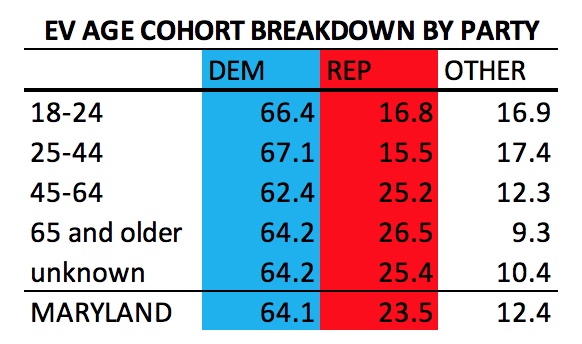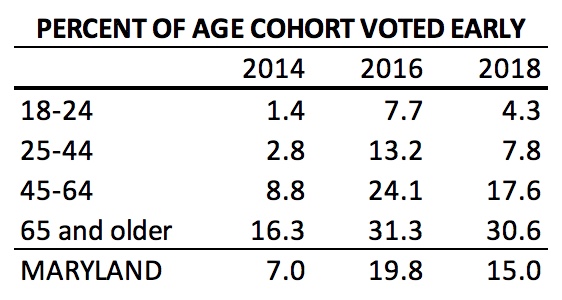 The above table shows the final statewide Maryland early vote broken down by age cohort for 2018.
The above table shows the final statewide Maryland early vote broken down by age cohort for 2018. Older voters dominated early voting in absolute and relative terms. Voters 45 and older composed three-quarters of early voters. Democratic early voters skew a bit younger and Republican early voters a bit older.
Older voters dominated early voting in absolute and relative terms. Voters 45 and older composed three-quarters of early voters. Democratic early voters skew a bit younger and Republican early voters a bit older.
Interestingly, unaffiliated and minor party voters skewed notably younger than either major party. The two youngest cohorts comprised 31.8% of early voters, as opposed to 23.1% for Democrats and 14.8% for Republicans.
These differences likely reflect differences in the age composition of the pool of registered Democrats, Republicans and unaffiliated voters. It has been a long-time trend for newer voters to be less inclined to register with a party but I’d like to confirm that this national trend applies to Maryland registrants.
 Unsurprisingly, Democrats dominated early voting in all cohorts with some variations. Interestingly, Dems were a smaller share of 45-64 early voters than either 25-44 or 65 and older voters.
Unsurprisingly, Democrats dominated early voting in all cohorts with some variations. Interestingly, Dems were a smaller share of 45-64 early voters than either 25-44 or 65 and older voters.
The real difference, however, are between the share of Republicans and unaffiliated early voters. The share of Republicans among early voters is about 10% lower in the two youngest cohorts compared to the two older cohorts. In contrast, unaffiliated and minor party registrants were a greater share among the younger cohorts.
 The final data verify my earlier conclusions that there is no real sign of a youth wave in Maryland. The above table shows estimated rates of early voting among the general population by age. In Texas, early voting among the young was up at far higher rates than in Maryland. Additionally, young Texans increased early voting by more than older Texas. Not here.
The final data verify my earlier conclusions that there is no real sign of a youth wave in Maryland. The above table shows estimated rates of early voting among the general population by age. In Texas, early voting among the young was up at far higher rates than in Maryland. Additionally, young Texans increased early voting by more than older Texas. Not here.
Consider that voting among the youngest cohort increased 2.9% from 2014 while it was up 5.0% among 24-44 year olds, 8.8% among 45-64 year olds, and 14.3% among 65 and older. Similarly, the fall off from 2016 was greater among the young. Among 18-24 year olds, 2018 turnout was 56% of 2016 turnout. In contrast, for 25-44 year olds the equivalent figure is 59%. For 45-64 year olds, it’s 73%, and for the 65 and older crowd, it’s an incredible 98%.
Early voting provides no sign of a youthful blue wave. We’ll have to see what the electorate looks at the end of Election Day. But the current bottom line is that changes in early voting look a lot different in Maryland than in states like Texas.
The good news for Democrats is that early voting was way up in 2018. Some contend that this merely reflects the general trend towards more early voting. However, the jumps from 2012 to 2016 and 2014 to 2018 have one key factor in common: the incredible polarization that Donal Trump brings to politics.
My expectation remains that, even though the electorate in 2018 may not be quite as favorable to Democrats as in 2016, the electorate this year will look a lot more like 2016 – a good year for Democrats – than 2014 – a good year for Republicans.
(Written hurriedly. Please excuse inevitable typos and other errors.)
